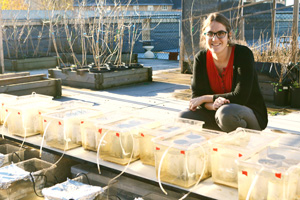14 December 2016
Could your Christmas socks gift harm the environment?

Dr Claire Passarelli beside the experimental tidal tanks
Today’s high-tech odour-busting socks might make this traditional Christmas gift a more interesting present at last, but what about their effect on the environment?
Silver nanoparticles, which kill odour-causing bacteria, are being increasingly used in socks and sports clothing. However, this means that during their manufacture and use these products release those nanoparticles in the water, which are toxic pollutants and ultimately reach estuaries and coasts.
Scientists at the University of Essex are now researching the impact of these nanoparticles on the ecology of coastal areas. Nanoparticles are between 1 and 100 nanometres (billionth of metre) in size and due to their unique properties are being added to more and more consumer products, such as clothing and food packaging.
Our oceans are known as the lungs of the planet as they produce the most oxygen, whilst at the same time playing a vital role in trapping CO2 emissions, limiting its accumulation in the atmosphere. In coastal areas, micro-algae covering mudflats are responsible for most of this carbon and oxygen cycling.
An EU-funded research project (Marie Skłodowska-Curie actions) led by Dr Claire Passarelli and Professor Graham Underwood, from the School of Biological Sciences, is now trying to find out how these toxic nanoparticles impact micro-algae and the biodiversity of our coastal areas.
Using mud and water from the Essex coast, Dr Passarelli has created a system of outdoor tidal tanks to test the effect the nanoparticles have on the micro-algae. The experiments during the two-year project will test the impact of silver nanoparticles, such as used in socks, and titanium nanoparticles which make up between 5-10% of sun cream.
“These nanoparticles are toxic chemicals but there is no legislation around them being released into our waters,” explained Dr Passarelli. “By using different experimental tanks to monitor different scenarios using natural light and temperatures in different seasons we can find out the real impact these nanoparticles are having on our coastline.
“This project will provide information to guide policy-making on nanoparticle disposal and on environmental quality standards for nanoparticle concentrations.”
...more news releases